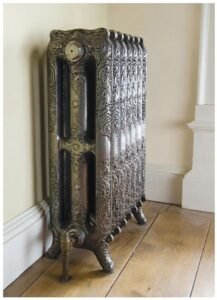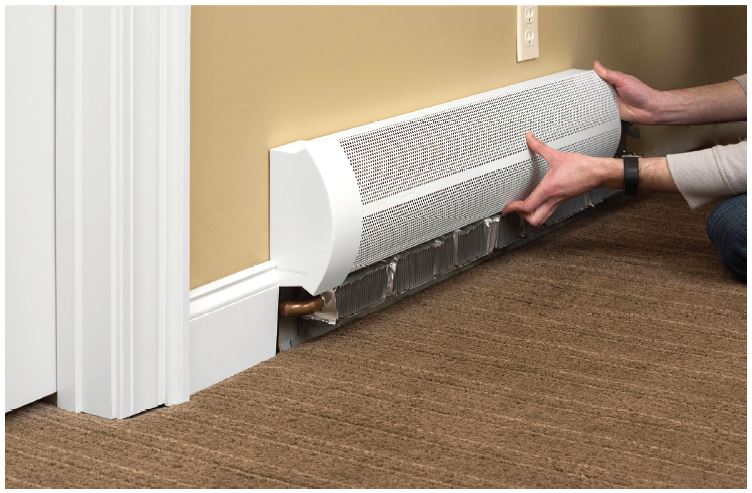Written on: December 11, 2023 by George Carey
As much as technicians may like the challenge of fixing a problem on an old steam system and bringing it back to its once majestic self, there are times when it makes sense to convert the steam system to a hot water system. Reasons could perhaps involve improved comfort and zoning capabilities for the homeowner, fewer headaches or a more efficiently operating heating system.

Let’s go through some steps to consider when converting from a steam system to a hot water system.
Assess the Existing Components
One of the first things to evaluate is the existing radiators. If dealing with radiators that are cast-iron column type with a wide space between each section, the conversion will not make sense. These column-style radiators were perfect for steam because they offered plenty of internal space, which allowed the steam to rise up while the condensate could easily slide down past it. However, because the sections are not connected with push nipples across the top, water is prevented from flowing effectively through each section.
If the radiators in the house are cast-iron tube style (with much thinner sections), there will be push nipples across the top of each sections. This will allow the water to flow throughout the sections and will work properly when converted to a hot water heating system.
Next, check whether the existing system utilizes one pipe or two pipes (obviously, the number of pipes connected to the radiator will determine the answer). If the system is one-pipe, it’s not practical to turn it into a hot water system; it can be done, but you will be drilling and tapping an outlet on the opposite side of each radiator for the return pipes. However, conversion to a hot water system will be possible with a two-pipe system. When inspecting a potential system for conversion, walk throughout the entire home or building and make sure all the radiators are piped for a two-pipe system.
Perform a Heat Loss Test
Performing an accurate heat loss inspection on the house is the next step before converting the system to hot water. Make sure to measure the square foot rating of Equivalent Direct Radiation (EDR) of all the radiators in the building; you want to ensure that when you convert the system to water, the amount of radiation will be sufficient to heat the house on the coldest days of the heating season.
For example, if the radiators are filled with steam at 1 psi, the steam temperature is 215ºF. Each square foot rating of that steam radiator could emit 240 BTU/H. When converted, the water temperature will only be 180ºF. Each square foot of radiation will emit 150 BTU/H. The question is, will there be enough radiation while circulating this lower temperature to keep the house warm? If the windows have been upgraded and insulation has been added to the structure—and if the original heat loss was perhaps exaggerated—the existing radiators should provide enough heat to keep the house warm.
Check for Leaks
Remember that a steam system operates at a typical pressure of no more than a couple of pounds. When converted to water, the static system pressure could be operating as high as 15–20 psi, which will surely reveal any leaks the system may have. If the steam boiler is still operable, crank the boiler pressure up to 10–12 psi and walk throughout the house, looking for any leaking steam or condensate. By doing this, you will have an idea of what needs to be addressed before the system is completely filled with water.
Evaluate the Piping
The next step is to completely remove each thermostatic radiator trap and replace it with an elbow and piping. Another option is to keep the traps, but take the covers off and remove the thermostatic element and, with a rag, wipe clean the seat of the trap. With the elements removed, the water will be able to flow through the radiator and into the return piping.
In some conversions, the steam piping is removed completely and re-piped with either copper or Pex piping. In other instances, the plan is to reuse the existing supply-and-return steam pipes.
A word of caution: the main return piping may be too small for the hot water system. When a steam system condenses back to condensate/water, the volume is very small, especially when a steam system condenses back to condensate/water, The returns from each radiator, which are typically ½” in size, will be able to handle the radiator flow rate; however, the main return line may have to increase to handle the flow from all the radiators.

The new hot water boiler should be piped as you would normally pipe hot water boilers. Also, plan on removing any of the “near boiler” piping from the old steam system. Make sure to include an air separator, pressure reducing valve, circulator(s) (if you are zoning the new hot water system) and an expansion tank.
When selecting the expansion/compression tank, be sure to account for the additional water the system will have from the cast iron radiators as well as the steam supply piping. Expansion tank sizing is all about the volume of water in the system, not the BTUs of the boiler.
After going through all of these steps to make sure the conversion will be successful, you can see why sometimes the heating contractor may suggest keeping the steam system!
If you have any questions or comments, e-mail me at gcarey@fiainc.com, call me at (800) 423-7187 or follow me on Twitter at @Ask_Gcarey. ICM